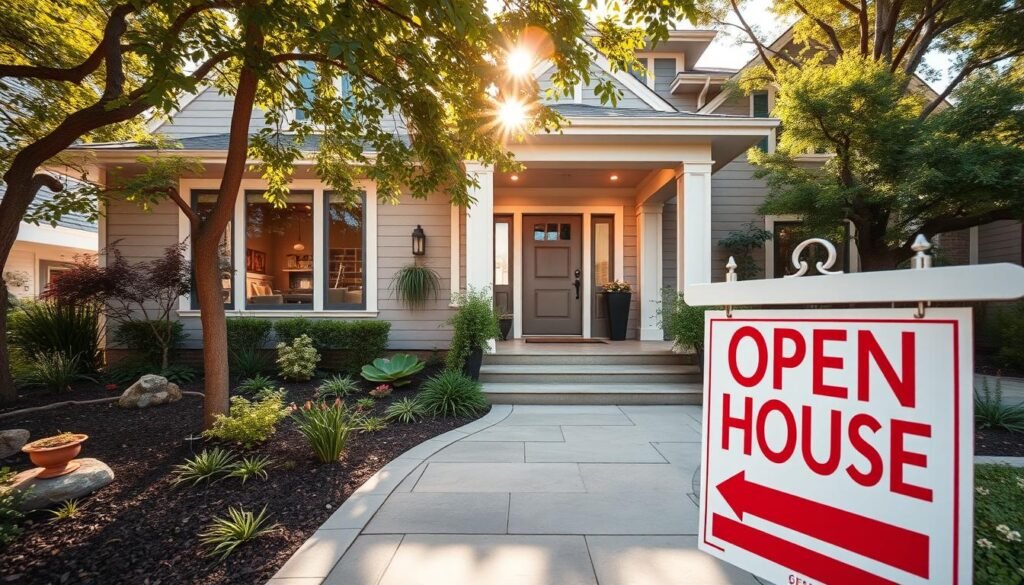Starting in real estate investing can be thrilling and scary at the same time. The dream of making money through house flipping is tempting. But, it’s a journey that needs careful planning, budgeting, and smart choices. With the right approach and tools, you can overcome renovation challenges and make your real estate dreams come true.
As a new real estate entrepreneur, learning about cost-effective renovations is key. By making your investments count, you can increase your property’s value and profits. In this guide, we’ll share strategies, techniques, and best practices to help you flip smart and reach your financial goals.
Key Takeaways
- Successful house flipping requires thorough market research, understanding property values, and strategic renovations.
- Budgeting and securing the right financing are essential for maintaining profitability in house flipping.
- Prioritizing high-impact renovation projects can significantly increase the value of your properties.
- Effective pricing and marketing strategies are crucial for maximizing profits when selling a flipped property.
- Building a reliable network of contractors and professionals can greatly enhance the success of your renovation projects.
Understanding the Importance of Cost-Effective Renovations
Starting a home renovation project is exciting for new real estate investors. But, it’s important to focus on cost-effective strategies. These strategies help you make more money when flipping houses. By planning and doing budget-friendly improvements, you can increase the property’s value and save money.
Why Renovation is Key to Real Estate Success
Real estate investing success often depends on finding properties with hidden potential. Renovating these properties can turn them into homes that many buyers want. This leads to quicker sales and more profits, making renovation essential for smart investors.
The Benefits of Cost-Effective Strategies
- Higher ROI: Planning and doing cost-effective renovations can greatly increase the property’s value. This means you get more money back from your investment.
- Faster Sales: Budget-friendly renovations make your property more appealing to buyers. This can help sell the home faster.
- Improved Market Competitiveness: In a competitive market, properties with quality, affordable renovations stand out. They have an edge over those with higher costs.
Common Misconceptions about Renovation Costs
New real estate investors often underestimate renovation costs. They might think DIY work saves money or overlook what buyers really want. But, successful flippers know how to balance quality with cost. They focus on improvements that buyers value most.
| Renovation Project | Average Cost | Average ROI |
|---|---|---|
| Minor Kitchen Remodel | $21,000 | 81% |
| Midrange Bathroom Renovation | $19,000 | 70% |
| Steel Entryway Door Installation | $1,471 | 91% |
Knowing the costs and potential returns of different renovations helps you make better choices. This way, you can use your budget wisely and increase your chances of success in real estate investing.
Setting Your Renovation Budget
Setting a realistic renovation budget is key to successful house flipping. By calculating your expenses and planning for surprises, you can keep your project on track. This ensures you get the most return on your investment (ROI).
How to Calculate Your Renovation Expenses
Start by listing all possible costs, like materials, labor, permits, and surprises. Look at market trends to guide your decisions. Knowing the local demographics can help you predict selling rates.
Working with a seasoned contractor helps avoid cost overruns. Use project planning tools to set realistic budgets and timelines. Don’t forget to include labor costs for outsourced tasks in your budget.
Creating a Contingency Fund
It’s smart to set aside 10-20% of your budget for unexpected costs. This fund helps you handle surprises without ruining your project.
Tips for Sticking to Your Budget
- Prioritize renovations based on their impact and cost-effectiveness
- Obtain multiple quotes from contractors to ensure you’re getting the best value
- Consider cost-effective alternatives, such as using reclaimed or salvaged materials
- Utilize project management tools to track your expenses and progress throughout the renovation
By using these tips, you can manage your budget well. This helps you stay on track to meet your house flipping goals.
“Budgeting is essential; first-time flippers often underestimate renovation costs. Establish a realistic budget, include a contingency fund, and prioritize renovations.”
Prioritizing Your Renovation Projects
House flipping requires careful planning of renovation projects to increase your return on investment (ROI). Focus on key areas and use the 80/20 rule to get the best results.
Identifying High-Impact Areas
First, find the renovation projects that will add the most value. Upgrades to the kitchen, bathrooms, and curb appeal are key. These high-impact renovations can greatly increase your property’s value and attract buyers.
Utilizing the 80/20 Rule in Renovation
- The 80/20 rule means 80% of results come from 20% of efforts. Focus on the 20% of upgrades that will give you 80% of the value increase.
- Focus on updates that offer the highest ROI, like modern kitchens, updated bathrooms, and energy efficiency.
- Steer clear of unnecessary or cosmetic updates that won’t significantly raise your property’s value.
The Importance of a Renovation Timeline
Creating a detailed renovation timeline is key to managing resources and avoiding delays. Plan each step to keep the project on schedule and within budget. Consider material lead times, contractor availability, and market trends for a realistic timeline.
By prioritizing your renovation projects, you can maximize your ROI. This way, you can turn a fixer-upper into a profitable venture in the competitive real estate market.
Researching Your Local Real Estate Market
Starting as a real estate entrepreneur means you need to do your homework. Understanding the local market trends is key to success. This knowledge helps you make smart choices that boost your profits. It’s about knowing property values and what buyers want in different areas.
Understanding Market Trends in Your Area
Start by digging into the local real estate market data. Use sites like Zillow, Realtor.com, and Redfin to find out about recent sales and prices. Look at how prices change over time and how long homes stay on the market. This info helps you see where the market is now and where it’s headed.
How Location Influences Renovation Decisions
The location analysis is just as vital. It affects what renovations you should do. Think about the area’s demographics, what’s nearby, and what buyers like. For example, fancy upgrades might be better in rich areas, while simpler changes could work in other places. Knowing your location well helps your renovations meet the market’s needs.
Tools for Market Research and Analysis
- Use online real estate sites and listings to get lots of data.
- Get into local MLS systems for detailed property info and sales history.
- Check out government data like census reports for big-picture trends.
- Go to real estate events and talk to pros for direct insights into the local real estate market.
Doing thorough market research and analysis prepares you to make smart renovation choices. It helps you price your properties right and find the right buyers. This deep dive into the local market is a solid start for your real estate career.
DIY vs. Hiring Professionals: What to Choose
Choosing between DIY renovations and hiring professionals can greatly affect your project’s cost and quality. DIY can save money but might not be perfect if done wrong. On the other hand, professionals ensure top-notch results but can be pricey.
Benefits of DIY Renovations
DIY projects can save a lot of money. By doing it yourself, you avoid paying for labor. Plus, you learn new skills and feel accomplished. But, make sure you can handle the task to avoid mistakes.
When to Call in the Experts
For complex tasks like electrical or plumbing, it’s best to hire pros. They have the skills and licenses to do the job right. Their services might cost more, but they offer peace of mind and quality.
Balancing Cost and Quality
Finding the right balance between cost and quality is key. Think about your time and the project’s value when deciding. Sometimes, paying for professionals is worth it for top quality. For simpler tasks, DIY can be a smart choice.
| Financing Option | Interest Rates | Repayment Period | Collateral Required | Minimum Credit Score |
|---|---|---|---|---|
| Home Equity Loan | Lower than credit cards | 5-30 years | Yes (your home) | 640 |
| HELOC | Variable, could increase | 10-year draw period, then repayment | Yes (your home) | 680 |
| Personal Loan | Fixed, typically lower than credit cards | 2-7 years | No | 640 |
| Credit Card | Higher than other options | Varies | No | No minimum |
Deciding between DIY and hiring pros depends on the project’s complexity and your skills. Also, consider the impact on your property’s value. By finding the right balance, you can have a successful and affordable renovation.
Sourcing Affordable Materials
Starting a real estate renovation project? One key to staying on budget is finding affordable materials. Look for cost-effective sources to make the most of your budget.
Where to Find Cost-Effective Supplies
Look beyond traditional stores. Salvage yards, Habitat for Humanity ReStores, and online platforms are great for finding cheap, quality materials. These places often have affordable renovation materials that can cut your costs.
The Benefits of Reclaimed and Salvaged Materials
Consider using reclaimed materials in your projects. Items like vintage doors and repurposed wood can save money and add charm. They make your properties stand out and attract buyers who want something unique.
Using Online Marketplaces for Discounts
In today’s world, online marketplaces are a top choice for finding affordable renovation materials. Websites and e-commerce sites offer a wide range of discounted supplies. They often deliver right to your door, making it easy to find great deals.

“By sourcing materials wisely, I was able to transform a dated property into a stunning, move-in-ready home that sold for a premium price. The secret? Leveraging a network of trusted suppliers and online marketplaces to find high-quality, cost-effective supplies.”
Smart material sourcing is key to successful, budget-friendly renovations. Use alternative sources, reclaimed materials, and online platforms to achieve great results without breaking the bank.
Embracing Sustainable Renovation Practices
Starting in real estate? Sustainable renovations can change the game. They attract eco-aware buyers and save you money. Using green materials and methods boosts your property’s value and appeal.
Eco-Friendly Materials and Techniques
Choosing the right materials is key in sustainable renovations. Go for low-VOC paints, recycled insulation, and energy-saving appliances. Also, add water-saving and energy-efficient lighting. These changes make your properties more attractive.
How Sustainability Can Save You Money
Sustainable renovations can cut costs over time. Energy-efficient upgrades like windows and insulation lower bills. Plus, many green features qualify for tax breaks, increasing your profit.
Adding Value through Green Renovations
Emphasizing your property’s green features can draw in buyers. Homes with LEED or Energy Star ratings command higher prices. This strategy attracts buyers who value eco-friendly living.
“The construction industry is a major contributor to environmental damage, with the extraction and processing of building materials generating significant waste and pollution. By embracing sustainable renovation practices, we can reduce our impact and create more sustainable communities.”
Adopting sustainable renovation practices is wise for new real estate entrepreneurs. It saves money, increases property value, and appeals to eco-conscious buyers. Stay ahead by making sustainability a key part of your strategy.
Innovative Design Ideas on a Budget
As a new entrepreneur in real estate, making the most of your investment is key. Focus on budget-friendly design to boost your property’s appeal without spending too much. Use smart, affordable renovation ideas to make your properties stand out and attract many buyers.
Creative Ways to Enhance Curb Appeal
First impressions are everything, and making your property look good from the outside is crucial. Start with a fresh coat of paint to give your home a new look. Add some greenery, colorful flowers, and a tidy lawn to make it pop.
Don’t forget to update your exterior fixtures like the front door and lights. These small changes can add a lot of style and class.
Minimalist Design Strategies
For inside renovations, go for minimalist design to make spaces feel bigger and more open. Use simple colors and clean lines for a modern look. Choose furniture that does more than one thing to save space and look good.
Utilizing Color Psychology Effectively
Colors can greatly affect how people feel about your property. Learn about color psychology to pick colors that make your space feel welcoming and stylish. The right colors can make a room look bigger and more appealing, all while staying within your budget.

With these smart design ideas, you can refresh your properties without spending a lot. Paying attention to details and choosing affordable renovations can help you get the most out of your real estate investments.
Leveraging Technology in Renovation
Technology can change the game in real estate renovation for new entrepreneurs. It helps with project management and design visualization. The right renovation technology can make your flipping ventures more successful.
Smart Tools and Apps for Project Management
Good project management is key in renovation. Project management apps help you keep track of your budget, schedule, and team. They let you track expenses, monitor timelines, and coordinate with contractors all in one place.
Virtual Reality for Design Visualization
Seeing your renovation’s final look can be hard. But virtual reality design tools make it easier. They let you explore and tweak your design ideas in a virtual space. This way, you can make sure your renovation matches your vision before making any changes.
Automation Solutions to Reduce Costs
Automation can help you save money in your renovation. It includes smart home features for better energy use and 3D printing for custom parts. These solutions can cut costs and increase your property’s value.
Using technology can make your renovation projects better, more efficient, and profitable. Adopt digital tools and solutions to improve your flipping business. They can give you an edge in the fast-paced real estate market.
Effective Marketing Strategies for Your Renovated Property
As a savvy real estate entrepreneur, mastering property marketing is key. It helps show off your renovated gems and attract the right buyers. Whether flipping houses or transforming investment properties, smart marketing can boost your returns.
Highlighting Key Features in Listings
Your listings are the first thing buyers see. Make them count by highlighting the property’s best features and improvements. Use vivid language to describe the home’s new look and feel.
Include before-and-after photos to show off your renovation skills. This helps buyers see the value of your work.
Using Social Media to Attract Buyers
Social media is a powerful tool in today’s real estate world. Use platforms like Instagram, Facebook, and TikTok to showcase your properties. Share eye-catching visuals and virtual tours.
Use hashtags like #propertymarketing and #realestate to reach more people. Engage with your followers by answering questions and sharing renovation tips.
Networking with Local Real Estate Agents
Building strong relationships with local agents can help a lot. Share info about your renovated properties with them. Consider hosting events or open houses to showcase your properties and expertise.
By working with agents, you can reach more buyers. This can lead to more serious and qualified leads.
Effective property marketing is essential for your renovated investments. By focusing on key features, using social media, and networking with agents, you can attract the right buyers. This will help you maximize your return on investment.

Maximizing Your Return on Investment
Starting in real estate flipping? Making a good return on investment (ROI) is crucial for success. You must understand the local market value and how to appraise properties. Also, find the renovations that give you the best ROI and track your progress carefully.
Understanding Market Value and Appraisals
Start by analyzing the MLS and doing a comparative market analysis (CMA). These help you figure out property values and trends. Knowing this ensures your renovations fit the local market and boost your profits.
Renovations that Offer the Best ROI
- Kitchens and bathrooms are key areas for high returns.
- Energy-efficient upgrades, like LED lights and efficient HVAC, attract eco-friendly buyers.
- Improving curb appeal, especially near amenities, makes properties more appealing.
Tracking Your Renovation Progress
Keep a close eye on your renovation costs and schedule. Use about 30% of your budget for renovations. Aim for a sale price that guarantees at least a 20% return. Working with contractors one after another can cut down on time and costs.
By understanding market values, choosing smart renovations, and tracking your work, you’ll increase your chances of success in real estate flipping.
“Investing in the right renovations can make all the difference in the profitability of your real estate projects. Focus on maximizing your return, and the rewards will follow.”
Building a Reliable Network of Contractors
Starting as a real estate entrepreneur means you need a strong network of skilled contractors. Choosing the right ones is key to success. They help you deliver quality work that makes clients happy. A good network also leads to lasting business relationships, making your work easier and more competitive.
How to Evaluate and Select Contractors
Choosing the right contractors requires careful research. Look for those with a good track record, positive feedback, and a portfolio that shows their skills. Make sure they have the right licenses, insurance, and certifications to ensure top-notch work.
The Importance of Building Connections
Professional networking is vital for finding great contractors. Go to local events, join industry groups, and use your contacts to grow your network. Good relationships with contractors mean better prices, referrals, and service.
Creating Long-Term Relationships with Professionals
Building long-term business relationships with contractors is beneficial. Focus on clear communication, fairness, and teamwork. Having a preferred vendor list makes future projects easier, saves money, and ensures quality.
Real estate success depends on a reliable contractor network. Spend time finding, connecting, and growing relationships with these professionals. This will help your business grow and stay profitable.

“Successful real estate entrepreneurs understand the power of a strong contractor network. It’s the foundation that allows them to deliver consistent, high-quality renovations and build lasting client relationships.” – Industry Expert
Maintaining Flexibility During Renovations
Starting out in real estate, you’ll face many challenges. Being flexible is key to overcoming these hurdles. It helps you manage the ups and downs of renovation work and keeps your projects moving forward.
The Importance of Adaptability in Projects
Renovation projects often don’t follow the original plan. Being able to adapt quickly is crucial for success. You’ll encounter delays, material shortages, and unexpected structural issues. A flexible mindset helps you handle these problems smoothly.
Strategies for Managing Unexpected Challenges
- Develop contingency plans for common renovation roadblocks, such as unexpected cost overruns or scheduling conflicts.
- Implement nimble decision-making processes that allow you to pivot swiftly when necessary.
- Foster a problem-solving mentality, empowering your team to find creative solutions to unexpected challenges.
Keeping Stakeholders Informed
It’s vital to keep all stakeholders, like contractors and investors, updated. Regular communication helps manage expectations and keeps the project moving. This way, everyone knows what’s happening and when.
Being able to adapt and respond quickly is a big plus in real estate. It lets you overcome obstacles and seize new chances that come up.
Learning from Past Renovation Projects
As a savvy real estate entrepreneur, your success depends on learning and improving. Analyzing successful renovation projects can teach you effective methods. Reflecting on past mistakes helps you avoid them, making your future flips smoother and more profitable.
Analyzing Successful Renovation Case Studies
Study the success stories of real estate investors. Look at their strategies, challenges, and how they overcame them. Notice the design choices, material selections, and budget-friendly tactics that worked for them. These best practices can guide your own renovation projects.
What Mistakes to Avoid in Future Projects
Mistakes teach us a lot. Think about any mistakes or challenges in your past projects. Figure out what went wrong, why, and how to avoid it next time. This way, you’ll be ready to face future problems and save time, money, and stress.
Gathering Feedback from Prospective Buyers
It’s important to know what your target market wants. Talk to potential buyers, real estate agents, and industry pros about your projects. Learn what they like, dislike, and value most. This feedback will help you improve your renovations, focusing on what buyers want most.
By always learning, you can use past experiences to improve your future. Stay curious, adaptable, and in touch with your market. This is how you become a savvy real estate entrepreneur.
Empowering Yourself as a New Entrepreneur
Starting your real estate flipping journey as a new entrepreneur is exciting. It’s key to have a growth mindset that loves learning and being flexible. Success isn’t always easy, but being able to handle challenges and find new chances is crucial.
Developing a Mindset for Success
Build an entrepreneurial mindset that values progress over being perfect. Remember, every setback is a chance to learn and get better. Stay curious and open to new ideas and tools that can help your real estate projects.
By always growing, you’ll be ready for the changing real estate market. You’ll also be able to spot and use new trends.
Continuous Learning and Adaptability
The real estate world is always changing. To stay ahead, keep learning and improving your skills. Look for the latest news and tips through books, online groups, and mentors.
By always learning and being flexible, you’ll make smart choices. You’ll also be quick to adjust to market changes.
Building Confidence Through Action
Starting your entrepreneurial journey can be both thrilling and scary. Fight self-doubt by taking small steps towards your goals. Start with easy projects to build your confidence and skills.
As you get more experience, aim for bigger projects. Use your entrepreneurial mindset, love for learning, and flexibility to handle tougher tasks. Remember, confidence grows with action and reflection.